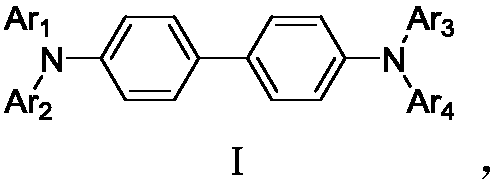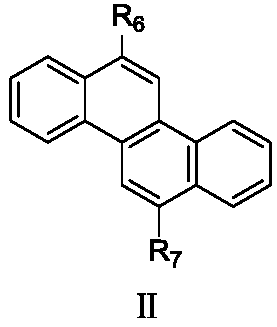Organic electroluminescent component
An electroluminescence element and electroluminescence technology, which are applied in electrical elements, organic semiconductor devices, electric solid devices, etc., can solve the problem of narrowing the energy gap bandwidth of the host material of the light-emitting layer, low hole injection and transmission efficiency, and blue light device luminous efficiency. Low problems, to achieve the effect of easy injection and transmission, easy charge dispersion, and not easy to crystallize
- Summary
- Abstract
- Description
- Claims
- Application Information
AI Technical Summary
Problems solved by technology
Method used
Image
Examples
Embodiment 1
[0107] [Example 1] Synthesis of compound HT5
[0108]
[0109] Step1: Under argon protection, add 5-chloro-1H-indole-2-boronic acid (10.2g, 52.3mmol), iodobenzene (21.3g, 104.7mmol), CuI (5g, 26.2mmol) to the reaction flask successively ), ethylenediamine (1.8ml, 26.2mmol), Cs 2 CO 3 (51.2g, 157.0mmol) and toluene (250ml), the reaction mixture was stirred for one day. The organic phase was extracted with ethyl acetate, the organic phase was concentrated and purified by column chromatography to obtain intermediate a-1 (7.1 g, 50%).
[0110] Step2: Under argon protection, add 8-bromo-1-naphthylamine (13.3g, 60.0mmol), compound a-1 (17.9g, 66mmol), NaOH (7.2g, 180mmol), Pd to the reaction flask in sequence (PPh 3 ) 4 (3.47g, 3mmol) and THF / H 2 O (80ml / 40ml), the reaction mixture was stirred at 80°C for 12 hours. After the reaction was completed, it was cooled to room temperature, extracted with toluene, and the organic phases were combined. The organic phase was washed w...
Embodiment 2
[0117] [Example 2] Synthesis of compound HT61
[0118] Compound HT61 (6.4 g, 72%) was obtained according to the synthetic method of compound HT5.
Embodiment 3
[0119] [Example 3] Synthesis of compound HT109
[0120] Compound HT109 (5.4 g, 69%) was obtained according to the synthetic method of compound HT5.
PUM
 Login to View More
Login to View More Abstract
Description
Claims
Application Information
 Login to View More
Login to View More - R&D Engineer
- R&D Manager
- IP Professional
- Industry Leading Data Capabilities
- Powerful AI technology
- Patent DNA Extraction
Browse by: Latest US Patents, China's latest patents, Technical Efficacy Thesaurus, Application Domain, Technology Topic, Popular Technical Reports.
© 2024 PatSnap. All rights reserved.Legal|Privacy policy|Modern Slavery Act Transparency Statement|Sitemap|About US| Contact US: help@patsnap.com










